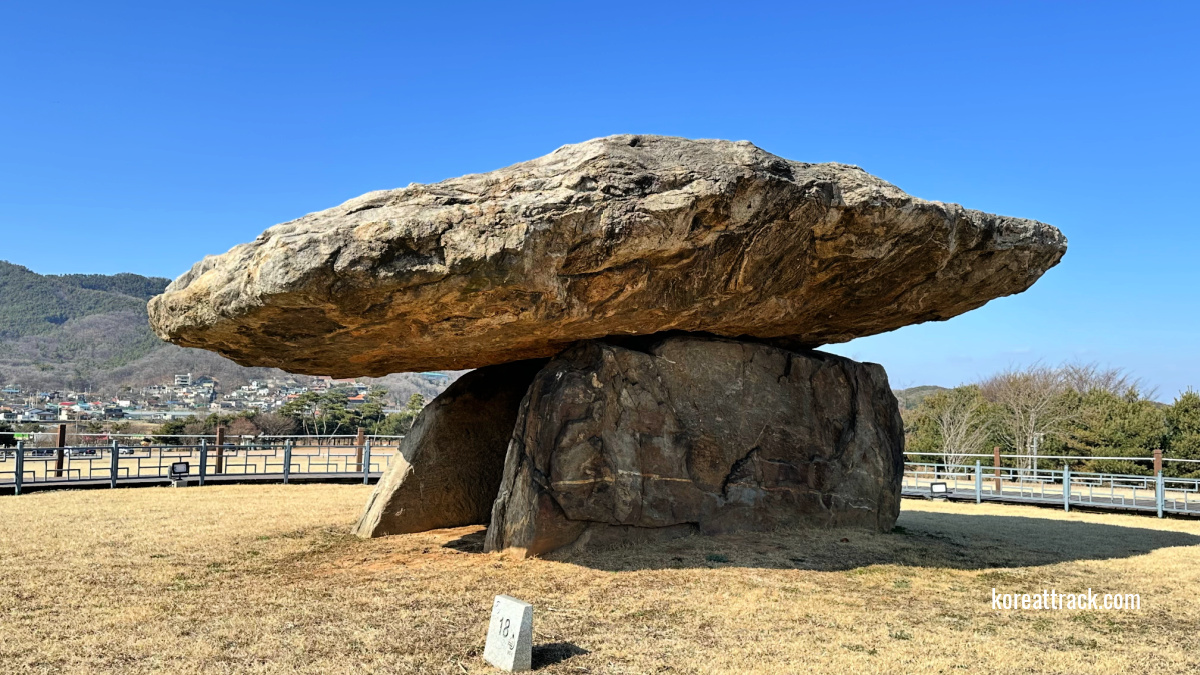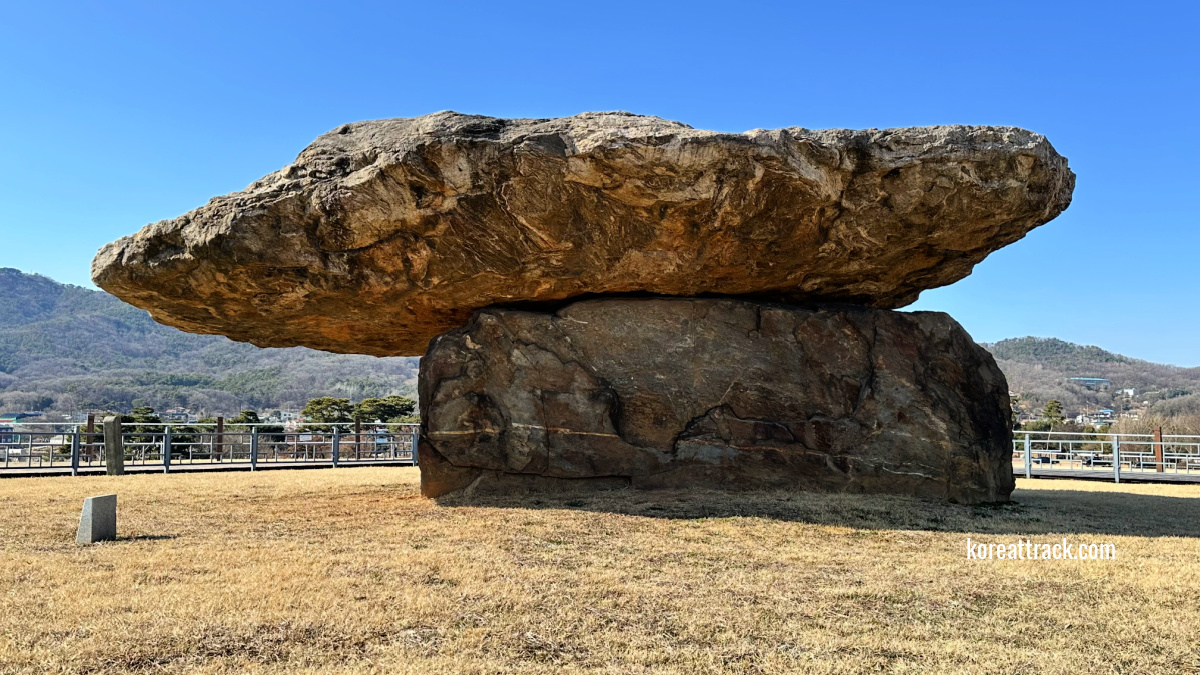Ganghwa Island Dolmens
in Bugeun-ri Village
 Ganghwa Island Dolmens in Bugeun-ri
Ganghwa Island Dolmens in Bugeun-riGanghwa Island Dolmens
Have you heard about the village of Bugeun-ri on Ganghwa Island? It has a rich cultural history and is home to an amazing collection of ancient stone structures called dolmens.
These structures were built long ago and are a testament to their incredible engineering and architectural skills.
Bugeun-ri is part of a larger group of Dolmen sites in Gochang, Hwasun, and Ganghwa that have been recognized as a UNESCO World Heritage Site since 20001.
If you're interested in history and culture, you'll want to check out these fantastic dolmens!
 Ganghwa(do) Island Dolmens
Ganghwa(do) Island Dolmens Pathway to the Dolmens
Pathway to the Dolmens A view of the Dolmen
A view of the DolmenI took the bus from Ganghwa Bus Terminal to the Dolmens site. I thought it would take about an hour, but it was only around 30 minutes - probably it was during the weekday, and the buses were not crowded.
I knew it was the right place because I could see the spacious land area covered with trimmed grass (still brown after the winter). I was very excited and immediately took out my phone, and started clicking my phone camera button!
Check out the story, theories, and my photos of the megalithic structure below...
Dolmens in Bugeun-ri
 Ganghwado (Island) Dolmens - massive stones that measure approximately 7.1 meters (23.3 feet) in length and tower up to 2.6 meters (8.5 feet).
Ganghwado (Island) Dolmens - massive stones that measure approximately 7.1 meters (23.3 feet) in length and tower up to 2.6 meters (8.5 feet).Bugeun-ri is a village on Ganghwa Island, a part of Ganghwa County, located in Incheon, South Korea.
The Ganghwa Dolmen Heritage Site in Bugeun-ri is known to house a remarkable collection of approximately 120 dolmens.
 Ganghwa Island Dolmens in Bugeun-ri is a UNESCO Heritage Site
Ganghwa Island Dolmens in Bugeun-ri is a UNESCO Heritage Site



These magnificent structures are predominantly of the Northern-style design and are constructed using large pieces of stone that skilled artisans have deftly assembled.
The dolmens found in Bugeun-ri are known for their impressive dimensions and sheer size. These structures are typically composed of massive stones that measure approximately 7.1 meters (23.3 feet) in length and tower up to 2.6 meters (8.5 feet).
The scale and grandeur of these dolmens are a testament to the ingenuity and skill of the people who built them.
Origin Theories
 The Ganghwa Dolmen Heritage Site in Bugeun-ri is known to house a remarkable collection of approximately 120 dolmens.
The Ganghwa Dolmen Heritage Site in Bugeun-ri is known to house a remarkable collection of approximately 120 dolmens.



There are three main theories about the origin of dolmens in Korea. The first theory suggests that the knowledge of dolmen construction and their existence spread from Southeast Asia along with rice cultivation.
This theory is based on the idea that the spread of agriculture led to the spread of knowledge and technology, including the construction of dolmens.
The second theory proposes that Neolithic tribes from southern Siberia and present-day Manchuria brought the knowledge of dolmen construction to the Korean Peninsula.
This theory is supported by archaeological evidence that suggests the presence of similar dolmens in these regions.
Finally, some argue that dolmens in Korea originated from Neolithic civilizations that existed within the Korean Peninsula itself.
This theory is based on the idea that the Korean Peninsula had its own distinct culture and civilization during the Neolithic period, which included the knowledge and technology required to construct dolmens.
Overall, the origin of dolmens in Korea remains a topic of debate among archaeologists and historians, with each theory providing its unique perspective on the region's history and culture.
Purpose and Artifacts
 Ganghwa Island Dolmen
Ganghwa Island DolmenDuring the first millennium BCE, the Megalithic Culture dominated the Korean Peninsula, leaving impressive megalithic structures as grave markers for the ruling elite.
These structures had significant ritual importance, and their discovery has given us valuable insights into the culture and practices of that era.
Excavations at these dolmen sites have yielded a treasure trove of artifacts, including pottery, comma-shaped jewels, bronzes, and stone tools, all of which provide us with a glimpse into the daily lives and customs of the people who lived during that time.
Dating & Cultural Significance
Dolmens are fascinating megalithic structures that can be found in Korea. For instance, the dolmens in Bugeun-ri are dated as far back as the seventh century BCE.
These structures were used to cover tombs and other vital structures, and their construction continued until around the third century BCE.
The Dolmen culture is closely linked with Korea's Neolithic and bronze cultures, and their significance to the region's cultural heritage cannot be overstated.
Bugeun-ri Dolmens Museum
 Ganghwa(do) Island Museum is located just across the Dolmens site and houses artifacts on Dolmens.
Ganghwa(do) Island Museum is located just across the Dolmens site and houses artifacts on Dolmens.Yes, there is a museum just across the road. It holds artifacts, dolmen stones, rocks, potteries, tools, and more evidence and records about the area's dolmens.
Visiting Ganghwa Island and exploring these ancient dolmens provides a unique glimpse into Korea's rich history and cultural heritage. The massive stones, carefully arranged, continue to intrigue and inspire visitors from around the world. 🌿🗿
Getting to Ganghwa Island Dolmens in Bugeun-ri
 Ganghwa Island Bus Terminal
Ganghwa Island Bus TerminalYou can find buses that travel to Ganghwa(do) Island at various spots in Seoul and neighboring provinces or districts, but you need to transfer from one transport to another. This is what I got from the bus terminal in Ganghwa Island (County).
Destinations: Seoul-Incheon
Ganghwa > Incheon Terminal, #700-1, 05:20 ~ 22:00
Ganghwa > Gumam Station, #700-2, 05:10 ~ 22:30
Ganghwa > Incheon Terminal, #800, 05:00 ~ 22:00
Ganghwa > Cheongla, #70, 05:22:20
Ganghwa > Bupyeong, #90, 04:00 ~ 22:15
Ganghwa > Yongdeungpo, #88, 04:10 ~ 22:00
Ganghwa > Shincheon, #3000, 04:20 ~ 22:00
Ganghwa > Gimpo Airport, #60-5, 05:10 ~ 21:00
Sources:
https://en.wikipedia.org/wiki/Dolmen_Sites
https://www.lonelyplanet.com/south-korea/gyeonggi-do/ganghwado/attractions/ganghwa-dolmen-park/
Onsite visit and observations
 Ganghwa Island Tourism Attractions board
Ganghwa Island Tourism Attractions boardIf you want to find out more about Ganghwado Island and other attractions in Gyeonggido Province, please continue scanning the links below.
Thanks for visiting this website, and have an amazing day!
- Home
- 15 Top Incheon Attractions
- Ganghwa Island Dolmens in Bugeun-ri
Get Exciting Activities
Book one of our exciting activities today to experience the thrill of a lifetime! Take advantage of this opportunity and secure your spot in advance.
Hotel Map Guide
Find your affordable, accessible, and comfortable hotel in Seoul at Agoda.Com. See the hotel map below...
Hotel Booking Guide
Find affordable and amazing hotels on Agoda.com using the search box below. Book now to enjoy great discounts and save!








New! Comments
What do you think about this page? Leave me a comment in the box below.